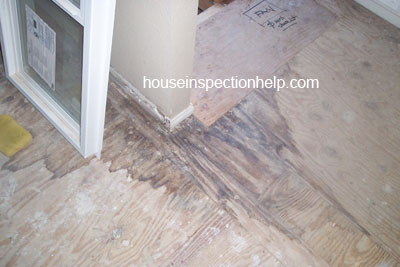Drywall Bottom Water Damage

You can clearly see the water damaged plywood floor stain that has
successfully worked its way around the lower section of this bathroom wall.
This also indicates a low spot in the floor by the way.
This is a
common problem in bathrooms suffering from poor construction, inferior
products and neglect. This is obviously something you won't get to see while
inspecting a home that has a nice layer of flooring (carpet or tile) on top
of the plywood subfloor. However, this will be a red flag, the moment you
see something like this after you have removed the bathroom flooring or
while you're in the process of remodeling a bathroom.
Water damage
can cause plywood subflooring to delaminate and weaken the floor. If this
happens, the plywood will need to be removed and replaced.

Now for the bad news, whenever there's bathroom floor water damage,
there's a good chance the drywall will be damaged also. What happens is
water sits on the plywood or concrete floor for a long period of time,
eventually soaking into the wood framing, connecting the floor to the wall
or directly absorbing into the bottom of the drywall or plaster.
It
isn't uncommon to find something like this in a bathroom that has been well
maintained. I can't tell you how many times I've removed baseboards or sink
cabinets and found drywall damage like this. This is something that will
need to be removed and replaced and don't skimp on these repairs.
You
will need to replace all of the water damaged drywall and it won't hurt to
go a little higher, just in case. If the damaged drywall is at least 12
inches off the floor, then it wouldn't be a bad idea to go another 6 to 12
inches. However, I'm going to leave that final decision of you and your
contract, what you replace or don't.
Wet or moist drywall can leave a
musty smell and I've even replaced all of the drywall or plaster in a
bathroom, just to remove the smell.

